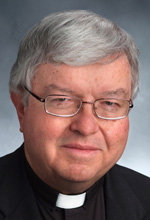Q. We have a question that we would like answered with reasons, not just words. We hear about pre-Cana for engaged couples, the Christian Family Movement for those with children, Marriage Encounter for those with problem marriages and separate retreats for men and women.
There is nothing for happily married couples who want to spend their trip to heaven together, as the unit they became when they were married. For what reason does the church not support the idea of couples being treated as one, as they strive to improve their spiritual life together? (Bluffton, S.C.)
A. First, may I expose and explode a myth which your question seems to embrace? Marriage Encounter is not meant for “problem marriages.” It is designed to make healthy marriages even healthier.
Worldwide Marriage Encounter says specifically that its program is not a “substitute for counseling.” Rather, it offers a weekend experience where couples learn a technique of communication that can deepen their relationship with each other and with God. As such, it is one of several programs designed for marriage enrichment.
The U.S. Conference of Catholic Bishops offers a website (www.foryourmarriage.org) that lists some of the programs described. (One of them is Marriage Retorno, a weekend prayer experience for husband and wife facilitated by a married couple and a Catholic priest.)
In addition, several dioceses offer programs that respond to your request. In my diocese, we offer a two-session workshop called Strengthening Relations that uses the standard Myers-Briggs personality test as a basis for teaching how different personality types can generate a healthy and harmonious match.
Q. When I was growing up, the tabernacle was in the front of the church on the main altar. I am upset that some Catholic churches today put our Lord in a small chapel in the back of the church. I consider that disrespectful and think that it must displease Jesus. (Bedford, Va.)
A. Whenever a Catholic church is built or renovated, perhaps no single issue prompts more debate, or stronger feelings, than the location of the tabernacle. Part of this has to do with the fact that church guidelines allow some discretion.
The General Instruction on the Roman Missal says in No. 315 that the tabernacle may be located “either in the sanctuary, apart from the altar of celebration … or even in some chapel suitable for the private adoration and prayer of the faithful and organically connected to the church and readily noticeable by the Christian faithful.”
Many older Catholics may remember the tabernacle’s having been in the center of the altar of sacrifice. The general instruction cautions against that so as not to distract from the celebration of the Mass. The two purposes, historically, of the tabernacle were to reserve the Blessed Sacrament for distribution to the sick and dying and to offer the opportunity for quiet adoration of the Eucharist when Mass was not being held.
In No. 314, the general instruction amplifies its guideline by clarifying that the tabernacle should be located “in a part of the church that is truly noble, prominent, conspicuous, worthily decorated and suitable for prayer.”
Pope Benedict XVI, in his 2007 exhortation “Sacramentum Caritatis” was even more specific, stipulating that “the place where the eucharistic species are reserved, marked by a sanctuary lamp, should be readily visible to everyone entering the church.”
Within these parameters of universal church law, the placing of the tabernacle falls within the discretion of a local bishop, and some bishops have chosen to issue guidelines in this regard.
***
Questions may be sent to Father Kenneth Doyle at askfatherdoyle@gmail.com and 40 Hopewell St., Albany, N.Y. 12208.
PREVIOUS: Pope: It’s impossible to live out Gospel without help from Christ, Mary
NEXT: Pope: Judging others kills, reflects cowardice in facing own defects




Share this story